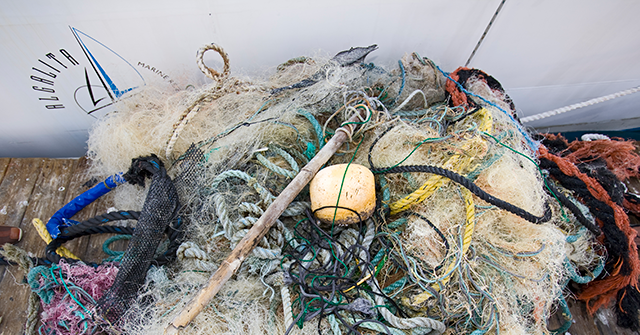A Dutch non-profit group called The Ocean Cleanup released a report on September 1 that found the bulk of the plastic debris in the so-called North Pacific Garbage Patch consists of discarded fishing equipment from Japan and China.
The garbage patch is often depicted in Western media and popular culture as refuse created by heavy industry or thrown into the ocean by careless Americans and Europeans. Much of the trash heap supposedly consists of minuscule debris known as microplastics.
The North Pacific Garbage Patch (NPGP), first discovered in 1997, was created by intersecting ocean currents between the West Coast of the United States and the Hawaiian Islands. Researchers later found small debris moving through a “subtropical convergence zone” to another garbage patch on the far side of the Pacific, east of Japan. The NPGP is estimated to cover several million square kilometers, weighing in at tens of thousands of tons.
According to research by The Ocean Cleanup published in Scientific Reports, up to 86 percent of the debris in the North Pacific Garbage Patch actually consists of “items that were abandoned, lost, or discarded by fishing vessels.”
The Ocean Cleanup began its revolutionary study in 2019, a year after a surprising survey that found almost half of the debris in the garbage patch was from discarded fishing nets. The study that began in 2019 harvested over 6,000 plastic objects from the ocean by dragging huge U-shaped nets behind research vessels. To the surprise of the researchers, the bulk of the identifiable debris they collected was “fishing and aquaculture gear,” including equipment used to harvest fish, oysters, and eel.
BREAKING: Our study, published today in @SciReports, reveals that 75% — 86% (by weight) of plastic debris in the Great Pacific Garbage Patch (GPGP) comes from fishing activities at sea. (1/6) pic.twitter.com/nKT4577E1N
— The Ocean Cleanup (@TheOceanCleanup) September 1, 2022
The new study concluded that Japanese and Chinese fishermen were the largest contributors of debris, with other sizable amounts contributed by Taiwan, the United States, and South Korea.
Counting Hong Kong and Macau along with China, the Chinese were responsible for 33 percent of the debris studied, Japan 35 percent, South Korea 15 percent, the United States five percent, and Taiwan three percent. Much of the debris was sourced by simply considering the writing and brand logos on plastic items.
“We found a fishing buoy dating from the 60s and a crate from the 70s, so this must have been building over time. More than half the ocean surface is now being fished, increasing the chance of fishing gear being lost, discarded, or abandoned in the ocean,” said lead study author Laurent Lebreton.
Lebreton said the “situation is worsening” due to “an exponential increase in plastic production over the last two decades.” His research suggests policies intended to reduce the amount of ocean waste should begin with the fishing industry.
Researchers were surprised by how little of the debris was commercial and industrial garbage floating into the Pacific Ocean from rivers. Until this study, rivers were thought to be the primary source of plastic garbage in the oceans, but it seems clear the bulk of the refuse is actually tossed directly into the Pacific from ocean vessels.
The study suggested that a great deal of the uncollectable “microplastics” – debris too small to be raked in by surface-skimming cleanup nets – could be created by the ocean vortexes at the heart of the NPGP grinding larger items down into tiny fragments.
Lebreton noted that physically hauling debris out of the garbage patch is difficult and carries the risk of harming marine life, so measures such as regulating equipment and waste management on fishing vessels, to address the problem at its source, are the best way to begin eliminating the oceanic garbage patches.
The authors of the new study noted that previous estimates of the size and composition of the NPGP were “misinterpreted from an initial study dating back to the 1970s,” producing some often-cited but inaccurate statistics.

















Discussion about this post